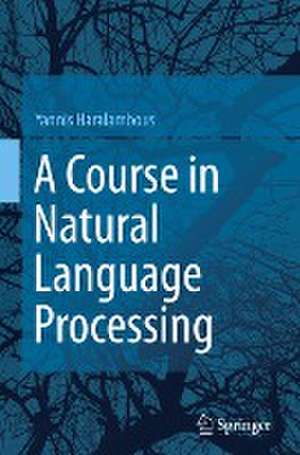A Course in Natural Language Processing
Autor Yannis Haralambousen Limba Engleză Hardback – 31 ian 2024
Based on a course on Natural Language Processing taught by the author at IMT Atlantique for over a decade, this textbook considers three points of view corresponding to three different disciplines, while granting equal importance to each of them. As such, the book provides a thorough introduction to the topic following three main threads: the fundamental notions of Linguistics, symbolic Artificial Intelligence methods (based on knowledge representation languages), and statistical methods (involving both legacy machine learning and deep learning tools).
Complementary to this introductory text is teaching material, such as exercises and labs with hints and expected results. Complete solutions with Python code are provided for educators on the SpringerLink webpage of the book. This material can serve for classes given to undergraduate and graduate students, or for researchers, instructors, and professionals in computer science or linguistics who wish to acquire or improve their knowledge in the field. The book is suitable and warmly recommended for self-study.
Preț: 664.77 lei
Preț vechi: 830.96 lei
-20% Nou
Puncte Express: 997
Preț estimativ în valută:
127.24€ • 138.26$ • 106.95£
127.24€ • 138.26$ • 106.95£
Carte tipărită la comandă
Livrare economică 22 aprilie-06 mai
Preluare comenzi: 021 569.72.76
Specificații
ISBN-13: 9783031272257
ISBN-10: 3031272250
Pagini: 534
Ilustrații: XVII, 534 p. 102 illus., 74 illus. in color.
Dimensiuni: 155 x 235 x 37 mm
Greutate: 0.95 kg
Ediția:1st ed. 2024
Editura: Springer International Publishing
Colecția Springer
Locul publicării:Cham, Switzerland
ISBN-10: 3031272250
Pagini: 534
Ilustrații: XVII, 534 p. 102 illus., 74 illus. in color.
Dimensiuni: 155 x 235 x 37 mm
Greutate: 0.95 kg
Ediția:1st ed. 2024
Editura: Springer International Publishing
Colecția Springer
Locul publicării:Cham, Switzerland
Cuprins
Preface.- 1. Introduction.- Part I. Linguistics.- 2. Phonetics/Phonology.- 3. Graphetics/Graphemics.- 4. Morphemes, Words, Terms.- 5. Syntax.- 6. Semantics (and Pragmatics).- 7. Controlled Natural Languages.- Part II. Mathematical Tools.- 8. Graphs.- 9. Formal Languages.- 10. Logic.- 11.- Ontologies and Conceptual Graphs.- Part III. Data Formats.- 12. Unicode.- 13. XML, TEI, CDL.- Part IV. Statistical Methods.- 14. Counting Words.- 15. Going Neural.- 16. Hints and Expected Results for Exercises.- Acronyms.- Index.
Notă biografică
Born in Athens, Greece, Yannis Haralambous studied Mathematics in Lille, France, where he obtained a Ph.D. in Algebraic Topology in 1990. Having meanwhile become a TeX aficionado, he then specialized in Digital Typography and founded the typesetting company Atelier Fluxus Virus, which is specialized in scientific and scholarly documents. In 2001, he became a Full Professor at the Computer Science Department of IMT Atlantique in Brest, France, and his research activities migrated to the disciplines of Text Mining, Controlled Natural Languages, Knowledge Representation, and Grapholinguistics. He has published more than 120 research or scientific popularization papers and a book on Fonts and Encodings (O'Reilly, 2004), has supervised 10 PhDs, teaches courses on NLP, Graph Theory and Logic, and is the organizer of the biennial conference “Grapholinguistics in the 21st Century”.
Textul de pe ultima copertă
Natural Language Processing is the branch of Artificial Intelligence involving language, be it in spoken or written modality. Teaching Natural Language Processing (NLP) is difficult because of its inherent connections with other disciplines, such as Linguistics, Cognitive Science, Knowledge Representation, Machine Learning, Data Science, and its latest avatar: Deep Learning. Most introductory NLP books favor one of these disciplines at the expense of others.
Based on a course on Natural Language Processing taught by the author at IMT Atlantique for over a decade, this textbook considers three points of view corresponding to three different disciplines, while granting equal importance to each of them. As such, the book provides a thorough introduction to the topic following three main threads: the fundamental notions of Linguistics, symbolic Artificial Intelligence methods (based on knowledge representation languages), and statistical methods (involving both legacy machine learning and deep learning tools).
Complementary to this introductory text is teaching material, such as exercises and labs with hints and expected results. Complete solutions with Python code are provided for educators on the SpringerLink webpage of the book. This material can serve for classes given to undergraduate and graduate students, or for researchers, instructors, and professionals in computer science or linguistics who wish to acquire or improve their knowledge in the field. The book is suitable and warmly recommended for self-study.
With a PhD in Algebraic Topology (Lille, 1990), Yannis Haralambous is a TeX aficionado and Full Professor at IMT Atlantique in Brest, France. His research interests cover Text Mining, Controlled Natural Languages, Knowledge Representation, and Grapholinguistics, topics in which he has published over 120 research or scientific popularization papers and a book on Fonts and Encodings (O’Reilly, 2007). He is in charge of IMT Atlantique’s “Data Science” Master track program, where he has been teaching the course that inspired this book.
Caracteristici
Offers a first, self-contained course to NLP based on a class taught by the author for over ten years Includes supplementary teaching material such as labs, exams or answers to general questions Presents a three-fold approach to learning a discipline at the crossroad of Linguistics, Mathematics and AI Request lecturer material: sn.pub/lecturer-material
